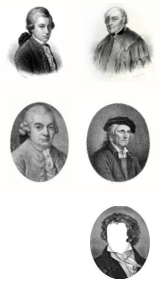

Welcome
This website is about composing classical music pieces using the computer and centuries old musical dice games. Musikalisches Würfelspiel (German for "musical dice game"), are an 18th century invention to compose random songs using a dice and precomposed musical bars.
'Composing' means 'putting together'. The fact that composing can be accomplished by swapping interchangeable pieces is proven by every blues and boogie composition, and by many pop songs: patterns are assembled and repeated. This method of swapping pieces is not only a hallmark of modern popular music. The form runs through the entire history of music, from Gregorian chants to the salon pieces of the Romantic period. The forms we are interested in here, musical dice games, were published all over Europe in the latter half of the 18th century. C.P.E. Bach, Haydn, and Mozart are only some of the names that are linked to these games (Reuter, 2013).

The authors of these 18th century musical dice games stated that an infinite number of compositions could be written by any amateur, without any knowledge of the rules of composing. The recommended tools were generally one or two dice. By throwing the dice and using certain tables, one could determine bar combinations which would sound as if they had actually been composed. Except for a few instances, the musical forms were dances such as menuets, contra dances or waltzes. Depending on the size of the table and the uniqueness of the bars, the number of unique compositions could range into billions.
"Eighteenth-century composers constructed musical dice games while nineteenth century composers did not. ... What constrained the choice of figures [in seventeenth- and eighteenth-century music] were the claims of taste, coherent expression and propriety, given the genre of work being composed, rather than the inner necessity of a gradually unfolding, underlying process [as in nineteenth century music]." ~ (Meyer, 1989).
The magic of those games was the apparently random way in which the music was produced. In fact, chance had little to do with the success of the music produced. Instead, what was required of the compilers was a limited knowledge of harmony and an understanding of the formal structure of waltzes, menuets, etc. The harmonic scheme and the metric structure remain the same for all generated 'compositions', which vary only in melody and rhythm.
Several other attempts have been made by others to write a computer program to emulate the process of throwing dice.
In this way the user is able to generate a new composition swiftly. Our goal is to enhance the utility and the ease of use by
applying the most advanced, 'state of the art' programming techniques on a selection of 18th century dice games,
and to make it also applicable to modern devices as tablets and smartphones as well. Compositions can be created
not only by emulating the use of dice but also by using any alphabetic or numeric combination (as names or dates).
We hope that this may stimulate the interest in 'randomly generated music'.
Enjoy!
References
- Meyer, Leonard (1989), Style and Music: Theory, History, and Ideology, 385 pages
(University of Chicago Press). - Reuter, Christoph. (2013), Der Würfel als Autor, Würfelmusik und Zufallstexte des 17. bis 19. Jahrhunderts. In: Herbert Bannert, Elisabeth Klecker (Hgg.), Autorschaft, Konzeptionen, Transformationen, Diskussionen. Wien, Praesens Verlag. p. 195-222.